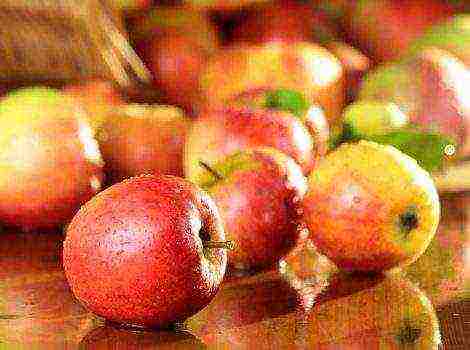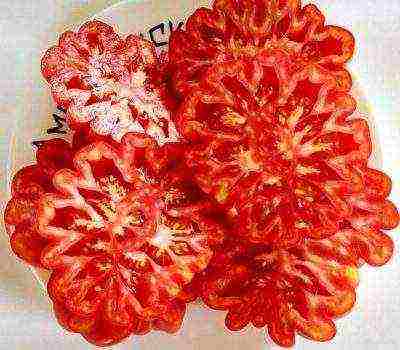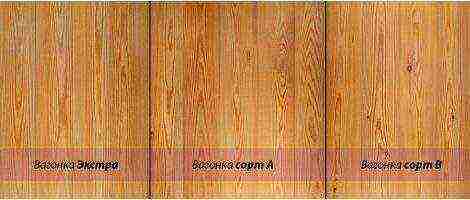Content [show]
Good varieties of radish are in great demand among gardeners - the fastest growing root crop. The messenger of spring and coming summer has delicious pulp, and it is also one of the first to be served at the table.
Radish
Almost all regions of the country are perfect for growing radishes, because it is a frost-resistant crop. Regardless of the particular radish variety, its yield and nutritional value remain virtually unchanged. Only soil fertility and adherence to the recommended growing conditions play a role in obtaining a good harvest. Among all varieties of radish, the early ones are considered the most popular, since they allow you to quickly get a rich harvest and start planting other garden crops. But do not discount the late varieties of this culture, which summer residents often grow on the windowsill. More details about the best varieties of radish and growing at home will be discussed in this article.
Radish seeds - the best varieties
Plant features
It is an annual crop belonging to the cabbage family. When planting, the vegetable forms a special storage organ called a root crop, as well as a leaf outlet. Many varieties are characterized by a long growing season, during which seeds, fruits and flowers are formed, and after that the plants die off. Radish has a taproot system that penetrates deep into the soil. The structure of the plant root is complex, it includes the root itself, leaves and a rosette.
Growing radish
On a note! Most often, the surface of the radish root crop is colored red. But there are varieties with other, more exotic flowers. It can be pink, purple or white. The most popular among the people is red radish.
The best varieties of radish
The shape of the fruit is also different - fusiform, round, oblong, and so on. The mass of radish fruits varies greatly, and therefore varieties are small (up to 20 g), medium (up to 50 g) and large (up to 200 g).
Elongated radish
The watermelon radish is raspberry inside and white and green on top. It looks like a small radish in shape. Its diameter is 7-8 cm
Unusual cutaway watermelon radish
Chemical composition
The popularity of radish is due to its rich chemical composition, so this vegetable is often used in the treatment of a number of ailments. First of all, radish roots contain a large amount of fiber, carbohydrates and vitamins (K, C, B9, B4). Among the trace elements, it is worth noting fluorine, manganese, iodine and iron. The macronutrients that make up the radish include phosphorus, magnesium, potassium and others.
Composition and useful properties of radish
Important! Radish is considered a low-calorie food, which is why it is included in numerous diets. 100 g of this vegetable contains no more than 16 calories.
The composition of the radish contains a variety of vitamins necessary for the normal functioning of our body.
Let's start choosing a variety
Most often, gardeners when growing radishes are faced with one problem - the plant goes into the arrow. There may be several reasons. First of all, this is the impact of weather conditions, too thick sowing, dry soil due to rare watering.But an equally important role in the development process is played by the choice of varieties, of which there are a lot. An inexperienced gardener can easily get confused when choosing a radish variety, so first you need to familiarize yourself with the main types. There are early, mid-early and late varieties.
Early
Early varieties of radish
You can get a radish harvest as quickly as possible if you grow early varieties of the plant. This group includes many different types, but the following are considered the most common.
- "Early red"... Excellent variety of radish, resistant to various diseases and shooting. It has red fruits of a round shape, the weight of which rarely exceeds 15 g. The yield of this variety is quite high - about 1.2-1.7 kg / m2. The disadvantage is the impossibility of long-term storage.
Early red radish
- "Ruby"... Differs in crimson-red rounded fruits. The fruit grows quite large, the diameter can reach 4.2 cm. It is a medium-yielding radish with white and juicy flesh.
- «Corundum"... A high-yielding variety with rounded red fruits, the mass of which ranges from 15-20 g. Most often used for growing in a greenhouse or on a windowsill.
- "Rhodes"... Not a high yielding variety. Differs in an unusual mild taste of fruits of a raspberry-red hue. Weight rarely exceeds 25 g.
Radish "Corundum"
Medium early
This group includes varieties that ripen approximately 25 days after planting in the ground. The best mid-early varieties of radish include those listed below.
- "Vera MC"... An excellent mid-early radish variety, distinguished by its bright red fruit color with tender and juicy pulp. Root crops do not crack, which is why they are well stored.
"Vera MC"
- "Prince of Denmark"... An excellent variety for greenhouse cultivation. It is distinguished by large oblong root crops, the length of which is 10-12 cm. The vegetable has a dense, juicy and tender pulp, which makes it an indispensable ingredient in the preparation of various dishes.
- "Slavia"... Gardeners know this mid-early variety under a different name - "Glory". It has red-pink fruits with a white tip, the length of which is 4-5 cm. The juicy pulp is distinguished by its slightly spicy taste.
- "Helios"... An unusual variety of radish, a distinctive feature of which is the yellow color of the fruit. The pulp of the plant is juicy and has a unique taste. It takes an average of 30 days until a vegetable is fully ripe.
Radish, grade "Jolly"
Late
This group of plants matures 40-50 days after planting. Let's get acquainted with the most common varieties.
- "Red giant"... Based on the name, it is easy to guess what is the peculiarity of this radish variety. Large fruits weighing from 250 g to 300 g. Root crops can be successfully stored for 5 months. A high-yielding and cold-resistant variety is planted in the first half of August.
Radish "Red giant"
- "Ramposh"... An unusual variety of radish with a white skin. The pulp is also colored white. Root crops are elongated, spindle-shaped. The taste is mildly spicy. Most often, gardeners use this variety for planting in open ground.
Rumposh radish variety
- "Würzburg"... It is a high-yielding late-ripening variety with spherical fruits colored crimson. Ripening of the vegetable occurs approximately 30-40 days after planting. Great not only for greenhouses, but also for open ground.
- "Champion"... Another late variety of radish, characterized by an elongated-round shape of the fruit, painted in a red-crimson color. Fruit weight - no more than 20 g.
Radish "Slavia"
Growing radish
Having decided on the variety, you can start growing the vegetable. This process is simple and not much different from the cultivation of other garden crops. The same preparation of seed, soil mixture, the same care and pest control.But still, novice gardeners often make trivial mistakes that could have been avoided.
Radish photography
Seed preparation
After purchase, the seeds need to be checked for quality. This is done as follows: the seeds are flooded with water, after which everything that floats up must be discarded. It is impossible to keep the seed in water for a long time, as this can negatively affect it. After discarding, germinate the seeds in a damp cloth or tissue. It is also recommended to take care of the prevention of seeds from various diseases. To do this, hold the seed in the prepared potassium permanganate solution (about 10-20 minutes). After that, the plant will get sick less often.
Radish seeds
Preparing the potting mix
If it is not possible to buy a ready-made mixture in a store or prepare it yourself, you can dig up the required amount of soil in the country - this is the simplest and cheapest solution. Only with such a decision, you should not count on a rich harvest, single weak shoots are the maximum that awaits you. But if you need a healthy crop, then it is better to buy soil or prepare it yourself. In the second case, you will need sand, humus and garden soil. Mix these ingredients in equal proportions.
Universal soil mixture
Choice of containers
In this regard, you need to rely on your imagination, because almost any container can be used as a container for radish seedlings. Often, gardeners prefer plastic containers or wooden boxes. But other containers can also be used - for example, egg cartons. Any of the options is good in its own way, because the most important thing is proper fit and care.
Selection of containers
Plastic cassettes for seedlings
Sowing
After you decide on the choice of variety, containers, and also prepare the soil mixture, you can safely proceed to sowing radish seeds. This process is not particularly difficult, so that every gardener can cope with the sowing.
Table. Sowing radish seeds in egg trays.
|
Step one |
Prepare everything you need for sowing. To some gardeners, this method may seem strange and doomed to failure, but you should not bury this idea in advance. If you are sowing several varieties of radish at once, then prepare a separate egg tray for each of them. |
|
Step two |
Fill the trays with potting soil. It is advisable to use store soil for this, but in extreme cases, you can take garden soil, mixed with sand and a small amount of humus. The soil must be moistened before planting. |
|
Step three |
After sprinkling the seed on a plate, carefully place one seed in each cell. Use tweezers for this purpose. |
|
Step four |
Sprinkle the planted radish seeds with a small layer of soil (about 10-15 mm) and tamp lightly with your fingers. |
|
Step five |
Pour warm water over everything. Since you used moist soil for sowing, you need to water it with a little water. You can do this with a spray bottle or a small enema - it all depends on your capabilities. |
|
Step six |
Create a greenhouse environment for the seeds by covering the egg tray with plastic wrap. If there is no film, place it in a plastic bag. Remember to punch a few holes on the top of the plastic to help the plants breathe. This can be done with an ordinary toothpick. Transfer the tray to a warm and lighted area until the seeds germinate. |
How to grow radishes
Follow-up care
Gardeners managed to fall in love with radish because of its unpretentiousness. This plant can be successfully grown on the windowsill - you just need to follow some rules for caring for the crop, and soon you will be able to pamper yourself and your family with delicious dishes with fresh radishes.
Radish seedlings
Crop care recommendations look like this:
- the optimum room temperature is + 17-20 degrees;
- after the appearance of the first shoots, watering should be carried out daily, just do not flood the plants;
- make sure that the radish seedlings are in a well-lit area. Use additional lighting sources if necessary;
- You cannot reuse the soil for planting another batch of radishes, since the plants will not be able to develop normally.
As you have already seen, there is nothing difficult in the process of growing radishes, so everyone can cope with this task.
A rich harvest
Video - What radish to plant (best varieties)
Radish is the first spring vegetable. Throughout April - May, you can sow radish seeds, getting a healthy and tasty early vegetable to the table. Early varieties of radish grow in 25-30 days. And, for example, the "Heat" variety is ready for use on the 18th day. I grow a few more early maturing radish varieties, but my favorite is the French breakfast variety.
Early radish varieties: photos, descriptions, reviews
After reading many gardeners' reviews on the forum, I will describe the most popular varieties of early and ultra early radishes.
Radish 16 days
The earliest early maturing radish variety for early distillation in open ground and in film shelters. The ripening period of round, even, bright red root crops is 16 days. The radish pulp is white, tender and very juicy. The taste is delicious, slightly spicy.
High-yielding variety, resistant to root cracking and shooting.
Radish seeds are sown in open ground at the earliest possible date, in late April - early May, to a depth of 2 cm, in lines every 7 cm, the distance between plants is 3-4 cm. Harvesting is carried out selectively, within a week.
Radish Heat
An early ripe fruitful variety, ripening on the 18-20th day. Radish root crop is smooth, rounded, red-raspberry color, with delicate pulp. The pulp is white or white-pink, dense, juicy, of mild taste.
Used for early forcing in open and protected ground. The Zhara variety is also suitable for winter sowing, while the seeds are planted deeper, approximately to a depth of 2-3 cm.
Radish Presto
An ultra-early ripening radish variety, ready to harvest on the 16th day. Root crops are bright red, rounded, very juicy. They have an excellent presentation.
Used for early forcing in open and closed ground. The variety is resistant to cracking and shooting.
Presto radish yield: up to 1.7 kg / sq.m.
Radish French Breakfast
A very popular early maturing radish variety that ripens in 21-23 days. Root crops are smooth, red-raspberry with a white tip, cylindrical, 6-8 cm long. The flesh is white, juicy, tender, with excellent taste.
The main advantage of this variety is its stable yield. This radish is disease-resistant and has excellent indicators of the quality of root crops.
Radish yield French breakfast: up to 2.5 kg / sq.m.
Sachs radish
An early variety, ready for use 20-23 days after germination. Included in the State Register of Varieties in 2007. Sachs is one of the most common early greenhouse radish varieties. Distributed in many regions of Russia.
Sachs radish has a rounded red root with a flat head, weighing an average of 11 grams. The flesh of this radish is white, tender and juicy, of excellent taste, slightly spicy.
Sachs radish yield: up to 1 kg / sq.m. Resistant to flowers.
Radish Carmen, description, photo
An early ripening variety that ripens in 20-22 days. Root crops are round-oval, red, with white juicy pulp and mild taste. Carmen radish yield: up to 1.9 kg / m².
Variety value consists in resistance to stalking and flowering, in suitability for long-term collection, high taste and good transportability. Recommended for fresh consumption.
Radish Rubin, characteristic
An early maturing variety for growing in open and protected ground, ripening in 25-30 days. Radish root crops are round, red, with white or white-pink juicy pulp and a slightly pungent taste.
Variety value in the amicable formation of the crop, as well as the uniformity of root crops.Ruby radish is recommended for fresh consumption and use in various salads.
Radish Champion
Early (ripening period 18-27 days from germination), high-yielding radish variety for open ground, film shelters, greenhouses.
The shape of the root crop is round (closer to oval), red-crimson, 3-3.5 cm in diameter, weighing 18-20 g, the flesh is white, dense, slightly sharp.
Radish yield Champion - up to 2 kg / sq.m. The variety is resistant to flowers and major diseases.
Sowing pattern: 7 x 7 cm.
Radish Celeste, characteristic
An early ripe, high-yielding radish hybrid. The period from germination to technical ripeness is 23-25 days.
The root crop is round, smooth, bright red, weighing up to 30 g, with high uniformity in shape. The pulp is white, juicy, homogeneous, does not coarse and does not form voids. The taste of this radish is excellent. Retains color and shine for a long time after washing and long-term transportation. Suitable for implementation both in bundles and by weight. Celeste F1 radish can be grown both outdoors and in greenhouses in winter.
Hybrid advantages: high stress resistance, resistance to shooting and cracking.
Sowing pattern: 7 x 7 cm.
Celeste radish yield: 1.5 - 1.7 kg / sq.m.
Radish seeds for greenhouses, video
Planting radishes
Radishes are grown all summer and even in autumn, but the most fruitful time is still the beginning of summer, before the heat.
Before planting, it is necessary to sort the seeds, select the freshest and largest. They are sorted in a 4-5% solution of sodium chloride, the floating seeds are removed, and the seeds that have settled to the bottom are washed. It is these seeds that will give good shoots. Then it is advisable to soak them in a solution of trace elements, which will accelerate the emergence of seedlings.
The radish bed is best done on light, fertile soil, well lit by the sun. If the land is not very rich, you can feed it with mullein solution, potassium chloride or ammonium nitrate.
Sowing is recommended at several times, starting from the end of April. Seeds are sown in grooves 1.5 cm deep, with row spacing of 10-12 cm and a distance between seeds of about 2-3 cm. To obtain larger root crops, thinning is carried out.
Pest control of radish
After the first shoots have appeared, it is necessary to immediately take measures against cabbage fleas and flies, which can destroy the first shoots. The agent "Aktofit" helps in this fight, it is effective against pests of radish. But this drug is easily washed off by watering or rain, so the treatment will have to be repeated. From home remedies, fleas are afraid of tobacco dust and ash.
If you sowed radishes in early spring, then, of course, you need to cover the crops with foil. Lift the foil occasionally to ventilate the seedlings.
To make the radish juicy it is necessary to water crops in the initial period at least 3 times a day.
Radish care includes weeding, loosening and thinning.
How to plant radishes, video. Convenient landing method
Reviews of radish varieties
What varieties of radish have you grown? Which ones did you like the most? What was the yield from 1 sq. m of area? Which varieties of radish are less susceptible to disease? Which radish has the least pests?
Your reviews and additions will help many gardeners choose the best varieties of radish for planting. The sweetest, tastiest, without bitterness, crunchy and dense, not friable, without voids inside.
If possible, attach a photo of the radish you have grown. Be sure to indicate the growing region. Then readers will be able to pick up varieties for the Moscow region, for Siberia and the Urals, for the entire middle zone. After all, not every radish that bears excellent fruit in the south is suitable for growing in the northern regions or, for example, for the northwest.
Today, it may even seem strange that radishes were previously considered an unusual and overseas vegetable. Some attributed to him mystical properties, either elevating his capabilities, then presenting him as something frightening and strange.
But in any case, it is worth noting that this vegetable helps to improve memory and increase immunity, having in its composition a huge amount of useful vitamins and minerals.
So that your harvest is worthy, and your efforts are not in vain, it is important to choose a variety that will taste good, give birth well and be able to attract attention with its appearance. After all, it is this product that needs to be served in the future.
Popular varieties
The most popular among all varieties are:
- Heat;
- French breakfast;
- The Red Giant is a late vegetable. It is special in that its roots can be stored in a cool place for several months... Such a crop ripens in 30-50 days. The variety got its name due to the size of the radish. The mass of such a vegetable can reach 0.3 kg;
- Zlata has bright golden color of the fruit with a slightly rough surface. The ripening period is 22-28 days. The weight of a medium-sized radish is 21 grams;
- Cherry Bella is a wonderful root vegetable that is distinguished by mild taste... It can be planted from April and the whole summer until September. In this case, the length of the day is completely unimportant for cultivation. It has a light taste with a slight spice.
 Radish Zlata
Radish Zlata
Shooting resistant
- Duro;
- Early red;
- Rondar F1;
- Lightning F1;
- Child F1.
For planting in open ground
- Ramtosh differs in that it is not at all capable of throwing out flowering. The root crop is white and fusiform in color. The pulp is white and tender with a medium-sharp taste. The variety is suitable exclusively for planting in the open field;
- Würzburg the variety can be harvested after 30-40 days after planting the seeds. The shape of its root crop is round according to the description. Its color is red with a slightly raspberry tinge. The pulp of the fruit retains its taste for a long time and does not deteriorate. That is why it is recommended to plant it not only in greenhouses, but also on open ground;
- Chupa Chups - a variety that in appearance is somewhat reminiscent of lollipops. Its roots are just as shiny and vibrant. The vegetable is very to the taste of the kids. Since it is not spicy, but even a little sweetish. It is recommended to plant seeds in April and May at intervals of ten days if there are problems with seedlings. Up to 3 kg can be collected from one square meter of the site;
- Camelot can be planted both outdoors and in a greenhouse. The growing season is on average about 23 days. The pulp is firm and oily. It has a snow-white color. If you store the radish correctly, it will retain its taste for a long time;
- Cherry Bella.
Late ripening
- Red giant;
- Ice icicle stands out from other varieties in appearance... White root vegetable, slightly pointed towards the bottom in the shape of a cone. It reaches almost 20 cm in length. It tastes good, crunchy and juicy, has a slight edge and a slight bitterness. The harvest of this variety can be harvested in 25 days, while the vegetable will reach its marketable appearance after 40 days;
- Dungan 12/8 stands out among all other varieties for its yield... From one square meter of land, you can get a practical 4 kg of yield. The ripening period of the vegetable is 40-55 days;
- Würzburg radish;
- The autumn giant is white in color, oblong in shape and has a pleasant taste. The average weight of one fruit is 80-150 grams. Practice shows that this vegetable is stored and does not grow old for about six months... Its ripening period is 25-30 days.
Early ripening
French breakfast
This is an early ripening vegetable, which you can harvest literally in 22-23 days.
Early maturity is possible subject to suitable weather. This root vegetable is crimson on the outside and white on the inside.
To taste, the French breakfast has light note of pungency and bitterness... Many people say that this is a very juicy radish. The weight of a standard medium-sized root crop ranges from 15-20 grams.
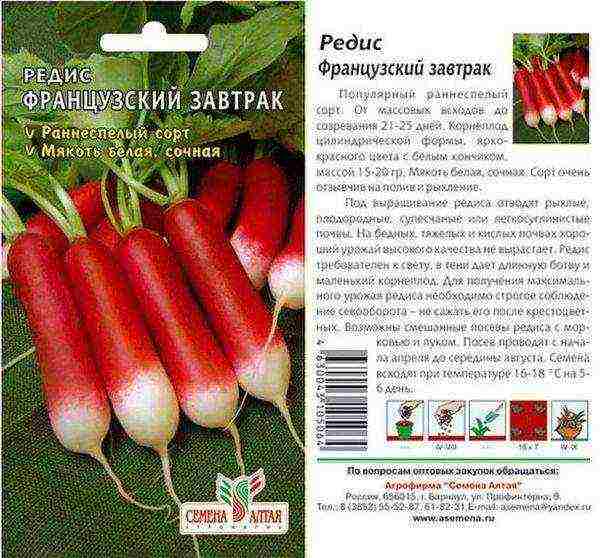 French breakfast
French breakfast
18 days
A variety of 18 days, which becomes clear from the name, is considered the earliest root vegetable, which is distinguished by its elongation and cylindrical shape. The average weight of the root crop is about 18 grams.
The outside color of the vegetable is pink with a white tail. Whereas the pulp is snow-white and dense. By its taste, radish is distinguished by a weakness of spice notes.
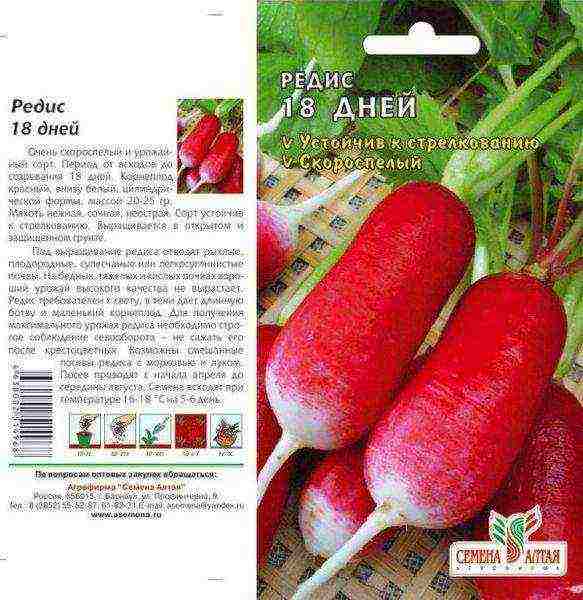 18 days
18 days
Firstborn F1
It is a hybrid variety that can be harvested within 18-19 days after planting the seeds. The root crop has a bright red or even crimson color. The average weight of a radish is 30-35 grams.
Do not forget also about high yield varieties. About 4 kg of radish can be harvested from one square meter. The plant tolerates heat well and is resistant to flowering.
This variety is recommended to be planted not only in the greenhouse, but also in the open field.
It showed good resistance to shooting. The root vegetable is pink in color and has a whitish tip. The vegetable is round and beautiful in shape. It also shows excellent qualities in taste.
Features of Radish Heat
Radish Heat belongs to the early maturing variety. Fruits ripen about twenty days after the emergence of the plant.
The radish root crop is distinguished by its roundness and smoothness of its outer side. In terms of color, it is a red vegetable with a slight raspberry tint. The mass of a medium-sized radish is about 30 grams. Its flesh is white.
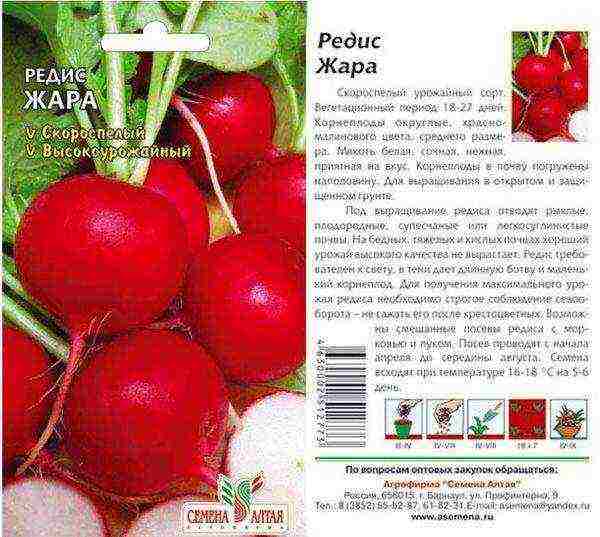 Heat
Heat
The pulp of the root vegetable is dense and juicy. Practical bitterness is not felt, although a note of pungency is still present. The taste of the Zhara radish is quite high.
You can grow radishes by planting seeds in open soil or under a film coating.
It is customary to use radishes fresh or to add to salads.
Disease resistance
Initially, this vegetable variety was bred for hot countries. That is why root crops better tolerate high temperature readings than low ones.
Especially a vegetable afraid of freezing... This type of radish is distinguished by good protection against various kinds of diseases and flowers.
Care
- to get a decent harvest, you need to choose the right site for planting. In our case, this is the place where the snow is likely to melt. Thanks to this, you can get a fresh harvest as quickly as possible. The best option would be a soil that is different lightness and high fertility;
- all vegetables and berries, with the exception of the cruciferous family, can become the preceding plants that were previously planted on the site;
- before planting, the soil must be fertilized;
- most experts advise planting a crop in the last decade of April... If something went wrong, you can re-land. But this is already in a couple of weeks;
- as soon as the first shoots appear, it is worth regularly loosen the ground;
- radish loves soil with high humidity, so do not allow the soil to dry out;
- if the crop has risen extremely thickly, you need to thin it out. The distance between individual roots must be at least 50 mm;
- if it is planned to plant plants in summer, it is recommended to shade the area. This is the only way to preserve the taste of the vegetable;
- to grow radishes in early spring or late autumn, it is worth additionally using film coatings.
A good harvest is always a lot of effort and labor of a gardener. And planting radish in this case is no exception. It is important to adhere to all the rules and recommendations that we considered in the article, and then beautiful and tasty root vegetables will decorate your table.
Foreword
The correct selection of a radish variety for each period of the planting season will allow you to continuously receive a bountiful harvest, from the first warm weeks of spring to autumn. All varieties are divided into types according to the ripening period and the place of cultivation: in greenhouses or open ground.
Early ripening radish - harvest in 16 days
Ultra-early, as these varieties of radish are also called, ripen in 16–20 days. These include Ultra Early, F1 Baby, 18 Days, F1 Randar, F1 Firstborn.The latter is an ultra-early hybrid, which is distinguished by a high yield, reaching 3.8 kg / m2. Ripens in just 16-18 days. after sowing. Root crops resistant to shooting and not subject to cracking, large, round, dark red, weighing 30–35 g, with a juicy pulp of sweet taste. The variety is mainly intended for growing in open ground. Sowed from April to late August.
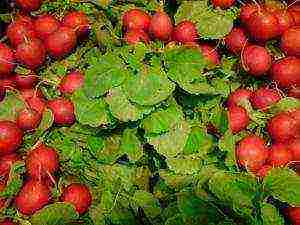
Rondar F1. Ripening time 18–20 days. The yield of this early maturing hybrid reaches 1 kg / m2. Root crops are red, with intense shine, rounded, weighing 10-15 g, with juicy, tender, white and pink-white flesh of excellent taste, which does not flake for a long time. This early hybrid has valuable qualities: high yield even in low light conditions, cold resistance, amicable ripening of root crops, resistance to flowering. Root crops Rondar are resistant to wilting, cracking and hollowness.

This variety is grown in open ground and greenhouse conditions in spring and autumn. Thanks to its short leaves, Rondar can be sown in cassettes.
18 days. Ripening period 18–20 days. Root crops are dark pink, cylindrical, oblong, with a rounded white tip. Juicy pulp of root vegetables of mild, delicate taste. Grows well in greenhouses outdoors.
Early Varieties - Heat or Early Red?
The fruits of early maturing radish varieties can be enjoyed in 21-30 days. from the moment of emergence. The most popular: Heat, Ilka, Early Red, Duro, French Breakfast, Zarya, Ruby and others.
French breakfast. A fairly popular and widespread early variety that yields a harvest for 24-27 days. after the first shoots. The yield reaches 3.7 kg / m2. Its roots are resistant to shooting, elongated-cylindrical, dark red, with a rounded white tip, weighing 40–45 g. Juicy pulp is not sharp and devoid of bitterness. The variety is suitable for open field sowing from spring in April to autumn in September. In the heat, it begins to go into the arrow.
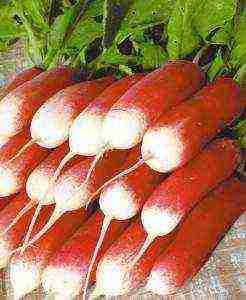
Ilka. Ripening period 24-28 days. Productivity in the range of 1.2-2.4 kg / m2. Root crops are red-scarlet, round, medium-sized, weighing 15–25 g, with juicy, dense, white and pink-white pulp, not subject to flabbiness and a pleasant medium-spicy taste that does not have bitterness. The Ilka variety is intended for sowing in open ground and greenhouse conditions; it can be grown all season, from April to September. In summer, from June to mid-July, when the daylight hours are the longest, it is recommended to shade the Ilka radish planting with a canopy. Advantages: resistant to low temperatures, does not shoot, is not prone to porosity, cracking and lining of root crops, on fertile light soils it is very high-yielding.
Duro. Harvesting ripe radish in 23-25 days. after the first shoots. It belongs to the most popular and productive early varieties. Its roots are red, round and extremely large: sometimes they reach 10 cm in diameter and 30–40 g in weight. Because of this, Duro radishes are sown according to the 10 × 10 cm scheme. The pulp of its roots is white and pink-white, tender, juicy crispy and delicious. This variety is resistant to stemming and flowering in hot weather and long days - optimal for growing in arid regions. Root crops do not woody and do not crack, they are stored for a long time. The variety is equally good for sowing in open ground and greenhouse conditions, it is characterized by amicable ripening of root crops.
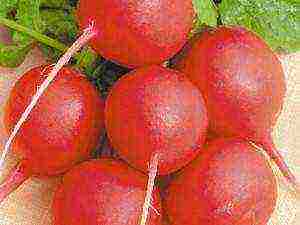
Heat. Ripening time 18-25 days. It is characterized by a high yield: based on the region, 0.9–2.9 kg / m2. Its roots are round, small in size, dark red, 15-25 grams each. The Zhara variety is time-tested and is very popular among gardeners. The radish has white-pink and white, juicy, tender, dense pulp with a slightly spicy pleasant taste, very rich in vitamin C. The variety is excellent for early sowing in open ground and in greenhouses.The name does not at all correspond to the preferences of this plant - it does not like heat, and it is not recommended to sow it in the summer (or it is necessary to cover it with a canopy).
Early red. Ripens in 24–31 days. Productivity in the range of 1.1-1.8 kg / m2. Its roots are small, smooth, round, dense, dark red, weighing 10–15 g. Early red is very juicy, its flesh is crispy, white, with a sweet-spicy pleasant taste. Advantages: germination rate of 99%; weak-leaved; Root crops are well formed on soils of various fertility in conditions of a long day and heat, ripen at the same time, are resistant to shooting and have high commercial qualities. The disadvantage is that it cannot be stored for a long time, it is intended for preparation and consumption only fresh. It is grown in any way (greenhouse or outdoors).
Mid-season varieties - the golden mean
Mid-season radish varieties ripen in 31–35 days. These include Saksa, Vera, Quantum, Alba, Zlata, Helios and others. Sachs. Ripening period 32–35 days. The yield reaches 1–1.6 kg / m2. Its root crops are of the correct round shape, raspberry-red, weighing 6-11 g, with juicy, white, delicate pulp of a sweet-spicy, pleasant taste. The Sachs variety is one of the most common species for early sowing in greenhouses, maturing amicably.
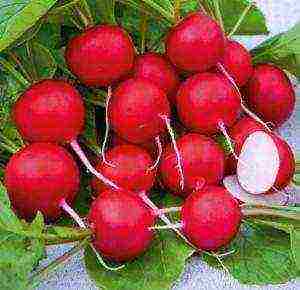
For early harvesting in the open field, it is used less often and not earlier than mid-spring. Suitable for summer cultivation. Disadvantage of Sachs: having reached technical ripeness, it is prone to early flabbling and going into the arrow.

Quantum. Root crops are round, raspberry-pinkish, with juicy, slightly spicy pulp, pleasant taste. The crop ripens amicably, suitable for long storage. Faith. The yield can reach 2.4 kg / m2. Root crops are bright red, uniform in size, resistant to shooting and not prone to cracking, with white, juicy, tasty pulp.
Late-ripening varieties - harvest by autumn
Ripening period 36–45 days. By autumn, the Champion, Dungansky, Rampous, Moskovsky Greenhouse, Red Giant and others will be pleased with the harvest. Usually they are sown in the 1st third of August.
Red giant. The yield reaches 3 kg / m2. Its roots are large, cylindrical, on average 14 cm long, bright red, with juicy, pink-white flesh of a slightly spicy, pleasant taste. This variety begins to be sown from mid-July. It is very resistant to pests (bear, cruciferous flea), excellently stored in the sand (up to 4 months).

Champion. The growing season is 40 days. Radish Champion is a high-yielding late variety, yielding up to 1.1–2.7 kg / m2. Root crops are elongated-rounded, large, smooth, raspberry-red, weighing 18–20 g, with tender, juicy, dense, white and pink-white pulp of good taste. Radish Champion is ideal for sowing outdoors, and during the early period - indoors, in a greenhouse. Root crops ripen together, they are resistant to voids, flabbiness and softening.
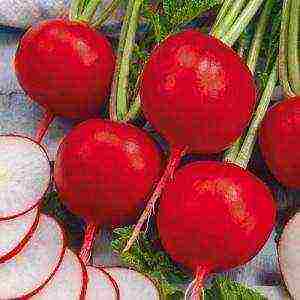
Dungan. Root crops are dark red, with a buttery pulp of a slightly spicy, pleasant taste. The variety is heat-resistant, loves watering, resistant to flowering. Grown in the second half of summer. Stores very well in winter. Rumposh. Matures 35–40 days. Root crops are long, fusiform, white, with a rather spicy pulp, but without bitterness. The variety is intended exclusively for growing outdoors.
Rate the article:
(2 votes, average: 4 out of 5)
